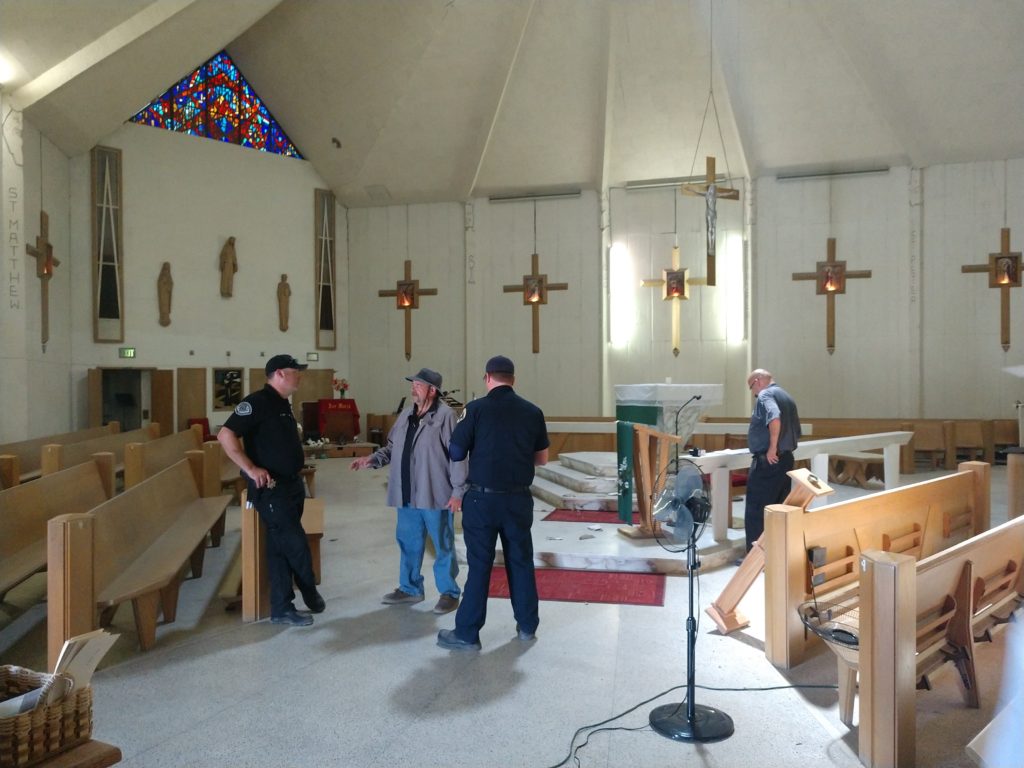Patricia Scyrkels was one of the first parishioners to set foot in Trona’s Catholic church after the earthquakes that struck the California desert July 4-5.
She could be one of the last.
Scyrkels was part of a small group to inspect St. Madeleine Sophie Barat following the first temblor, centered between Trona and Ridgecrest.
When she looked around her church, she was devastated by what she saw. Spilt walls, buckled floors, and broken statues all stemming from the 6.4 shaker. San Bernardino County officials determined that, pending further inspection, St. Madeleine’s is no longer safe for services.
The small 300-seat church, built in 1958, is a Mission of St. Joseph Parish in Barstow. Priests from the parish make the 100-mile trip to Trona twice a month to offer Mass. If there is a constant Catholic presence in Trona, it’s Scyrkels. She even has a key to the place.
“I work a lot with the church and it seems like everything I have volunteered for is ruined,” says Scyrkels. “I don’t know how to describe it. I just feel like the church is such a big part of my life.”
The initial quake took its toll, but it was only a taste of what was to come. The 7.1 that followed was so long and violent Scyrkels thought she might die.
“It was absolutely the scariest thing. My son and I got under the table and held on for dear life,” she recalls. “I prayed to God that if this was it, just forgive everybody in Trona their sins.”
Scyrkels voice breaks and she softly cries.
It wasn’t the end for Trona’s 2,000 residents but they were left with the crumbled remains of a town. Homes and driveways were riddled with cracks. Once tall chimneys were reduced to piles of bricks. Inside, dishes and lamps littered floors. Initially residents had no power or running water. Even when the water came back, it had to be boiled.
The San Bernardino County Fire Department says so far 31 area homes are red tagged as not habitable and 51 more are yellow tagged as having limited habitability. Eight commercial buildings are also red tagged including St. Madeleine’s. The former rectory, now an office building, is unscathed but the church and parish hall are another story.
“It’s more than just a crack,” says David Meier, Director of the Diocesan Office of Construction and Real Estate. “They’ve had displacement and uplift of the floor. Obviously, the floor holds the walls and the walls hold the roof. I’m really concerned about that damage.”
At press time, Meier was scheduled to return to Trona to conduct a more detailed inspection of the church in order to determine the next course of action.
“There is that potential that the structure of the church building may not be fixable,” says Meier. “I don’t know at this point. My hope is yes we can.”
Scyrkels moved to Trona in the mid-80s and has been a dedicated parishioner at St. Madeleine’s ever since. Knowing the building may not survive makes her so sad she can barely speak.
“The thought of not being able to go in our church again is just heartbreaking,” agonizes Scyrkels.
With the church currently uninhabitable, Mass will be held in the old rectory building.
“Whenever we go up there, we know they (parishioners) will come out,” says Father Michael C. Okafor, SMMM, Parochial Vicar at St. Joseph. “They appreciate the church. They appreciate the Sacraments.”
A week after the earthquake, a group of nuns and deacons made the trek from San Bernardino to Trona, bringing drinks and food like cereal, soup and canned fruit. They also brought boxes filled toiletries and baby supplies.
First Baptist Church in Trona, which suffered less damage than St. Madeleine’s, has taken a leading role in distributing donated items.
“For the Christian, this is our opportunity to show off our faith,” says Senior Pastor Larry Cox, First Baptist Church. “As people are coming to our church and getting goods, were taking some time to talk to them and see where they’re at.”
With some 70 significant aftershocks and counting, some of those people are just plain scared.
“They are still in shock right now. They need our prayers,” says Fr. Okafor.
Other residents are expressing anger or questioning why God is letting them suffer such a natural disaster. Bishop Gerald Barnes urges leaning on God instead of pulling away.
“Natural disasters frighten us and force us to consider what is the will of God in such a scenario,” Bishop Barnes said in a July 8 statement. “Let us take this moment of fear and uncertainty to draw ourselves closer to Him so that we are sustained by His love and protection.”
That’s what Scyrkels does and she wants more of her fellow Catholics to follow suit.
“Really I’d like a priest or nun to come up and talk to the parishioners that haven’t been coming to Mass and let them know how important God is in their lives,” says Scyrkels. “We just need to come together as far as I’m concerned. We really do.”
Bishop Barnes called for a special collection in parishes at July 13-14 Masses to help raise money for the earthquake relief effort.
Natalie Romano is a freelance writer for the Inland Catholic Byte and a parishioner of The Holy Name of Jesus in Redlands.

